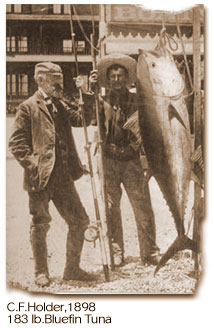Charles Frederick Holder (1851-1915) was one of the original pioneers in saltwater fishing (he founded the Catalina Tuna Club in 1898), in addition to being an important ichthyologist. He also wrote a number of stories for popular magazines. This one was published in The Metropolitan Magazine (Vol. 32, No. 67).

AN ADVENTURE WITH A GIANT CATFISH
By C.F. Holder.
A few years ago a party of Americans made their way in a trading-schooner up the Essequibo River, in British Guiana, to where the Mazaruni flows into it. From this point the journey was continued in a canoe rowed by a native crew. At a spot fully sixty miles from the mouth of the river, camp was made on a white, sandy beach.
Among a number of curious fishes these American travelers had noticed in the Essequibo was a catfish called by the natives the lanlan; and as several had been seen by them, preparations were made for their capture. A large line about two hundred feet in length was baited with fish and carried out into the stream by a small boat, a crotched stick being thrust into the sand on the beach, to which the line was attached to serve as a telltale, and around this a number of the party sat waiting for a bite.
In a little while there was a sudden jerk, and the line began running out in the hands of one of the Caribs. Twenty or thirty feet of " leeway" were given to tne rushing fish, and then several of the men grasped the rapidly stiffening line. As it came taut they braced themselves and jerked the hook into the fish. For a second there was no demonstration; then a violent plunge tore the line from their hands, hurling them upon the sands, and an enormous fish rose bodily out of the water, falling with a thundering crash and darting off at lightning speed. Knowing that when the slack-in was exhausteil the line probably would not stand the strain, it was quickly unfastened from the stick and attached to a small canoe, into which several of the fishermen sprang. This was not done a moment too soon, for with a rush the line straightened out. The boat seemed endeavoring to dive to the bottom, and then away it dashed, hurling the spray high in air behind the invisible steed.
For an eighth of a mile the great fish towed the canoe with undiminished speed, darting here and there among the sand-banks, now turning suddenly to one side, hurling the occupants off their feet and threatening them with constant danger of an upset. The strength of the gamy creature, however, was rapidly failing, and as soon as the speed slackened the men took the line in hand and endeavored to reduce the distance between them; but this resulted only in another furious burst of speed. Finally the line was torn from the bowman's hand and it slipped over the gunwale, and in a moment the water was pouring into the canoe. The crew rushed to the other side, climbing up, and finally succeeded in shifting the line and averting a catastrophe.
The line was again manned and the canoe slowly brought nearer the victim. After a long struggle the black form was seen darting back and forth under the bow. The man at the bow guarded the line closely, keeping it in the notch, while another native stepped forward, and raising a long, three-tined spear, drove it with all his force into the monster. The result was entirely unexpected. Enraged or frightened by this new attack, the fish seemed to pause for a moment, then rose into the air in a terrific leap, and fell upon the stern of the boat, carrying it down under water. As the monster fell, the crew, with the exception of one man, sprang overboard and swam for the shore; but the man in the end of the canoe climbed on the roof of the cabin-like part. As one end of the boat sank, he was lifted high in the air. The fish then, in its terrific struggles, rolled off, and the boat settled, with the terrified native still clinging to his high perch.
The fish was now striking the water with its powerful tail, rolling over and over, winding the line about its body, and giving every evidence of its wonderful strength, and might ultimately have escaped had not the party been followed by another canoe of natives, who, having picket! up the swimmers, made for the struggling lanlan. In a few moments several spears and arrows had been sent into it, and it was speedily despatched.
When the sunken canoe was righted it was found to be crushed in on one side. The harpoon lines were made fast to the fish, and it was slowly towed to camp and safely landed on the beach.
As the fish slowly rose and fell on the water behind the line of haulers, it certainly presented a remarkable appearance to our travelers. Nearly thirteen feet in length, it seemed much larger from its extraordinary bulk. The upper surface was a rich greenish-black tint with a silvery white below, the mouth and fins being a rich yellow. Its head, which was large and flat, was protected by a strong bony plate that extended back to the first dorsal fin. But perhaps the most unusual and curious feature was the long, slender barbels, or whiskers, nearly four feet in length, that depended from each side of the mouth, giving the fish an extremely grotesque and forbidding appearance.
-- Dr. Todd
1 comment:
Brother of hooks, Todd:
A fascinating story.
A hug and ...
An affectionate sapukay .
Post a Comment